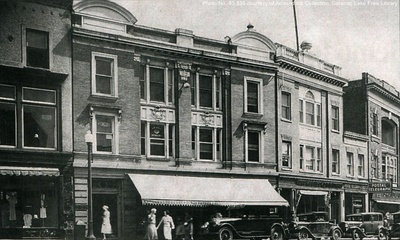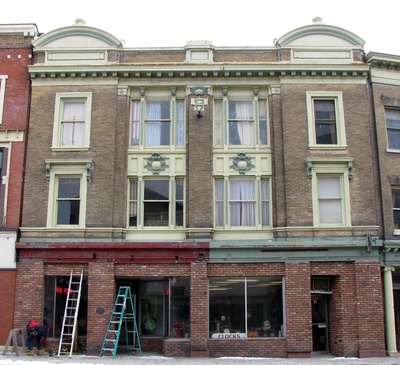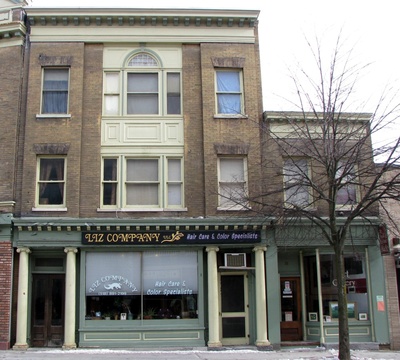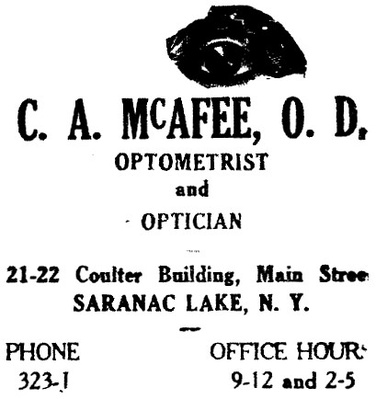 Coulter Block; automobile styles, and checking the business names with village directories, indicates that the photo was taken between 1927 and 1940, probably around 1936 when compared with a similar, dated photo. One of many undated photos in the Adirondack Collection of the Saranac Lake Free Library, this is part of a set of at least three photos of the center of the village with vintage cars in evidence. The large awning identifies Carey's, a high-quality men's clothier. This store was later divided in two; the L.B. Hunt Agency occupies the left-hand storefront. Liz Company, hair care, occupies the 1899 storefront with the columns, once William Kollecker's Kodak photo shop. Tim Fortune paints in his Small Fortune Studio where the Postal Telegraph did business. The separate building to the right, the Grand Union at the former 69 Main Street, lost its two upper stories in a bad fire in 1958, the former Meyer's Drugs. Adirondack Daily Enterprise, April 2, 2011
Coulter Block; automobile styles, and checking the business names with village directories, indicates that the photo was taken between 1927 and 1940, probably around 1936 when compared with a similar, dated photo. One of many undated photos in the Adirondack Collection of the Saranac Lake Free Library, this is part of a set of at least three photos of the center of the village with vintage cars in evidence. The large awning identifies Carey's, a high-quality men's clothier. This store was later divided in two; the L.B. Hunt Agency occupies the left-hand storefront. Liz Company, hair care, occupies the 1899 storefront with the columns, once William Kollecker's Kodak photo shop. Tim Fortune paints in his Small Fortune Studio where the Postal Telegraph did business. The separate building to the right, the Grand Union at the former 69 Main Street, lost its two upper stories in a bad fire in 1958, the former Meyer's Drugs. Adirondack Daily Enterprise, April 2, 2011  Coulter Block, left side, added in 1901
Coulter Block, left side, added in 1901  Coulter Block, right side, built in 1899
Coulter Block, right side, built in 1899  William F. Kollecker in front of Kollecker Kodak and Gift Shop
William F. Kollecker in front of Kollecker Kodak and Gift Shop  C. A. McAfee advertisement, Lake Placid News, September 21, 1923 Address: 76 - 82 Main Street
C. A. McAfee advertisement, Lake Placid News, September 21, 1923 Address: 76 - 82 Main Street
Old Address: 71-79 Main Street
Year built: 1899-1901
Architect: Designed and owned by William L. Coulter.
The two three-story brick buildings at 71-79 Main Street are known together as the Coulter Block. They are internally linked above the first story and they have aways been bought and sold as a unit, although they were erected separately.
The architectural firm of Coulter and Westhoff was an early link in a long chain of talent. The current link is the firm of Wareham and DeLair.
William L. Coulter was a master architect who moved to Saranac Lake and opened an office in 1895. On his drafting table, many of the greatest of the "Great Camps" took shape. He was joined at around the turn of the century by Max Westhoff, and William G. Distin, Sr. joined them in 1907.
Later that year, Coulter's health declined abruptly. Plans for the beautiful Nichols’ carriage house in Highland Park bear his imprint and the date April 25, 1907; but by October 27th he was so feeble that he had to sign his will with an "X" (it was witnessed by Westhoff and Dr. Charles C. Trembley). The will was executed on December 28th.
Though Coulter and Distin had but a few months to work together, the older architect's influence on Distin seems to have been considerable, as evidenced by the numerous half-timber and stucco houses designed by Distin — a style that was one of Coulter's favorites.
In February, 1899, Coulter purchased the site of 71-75 Main Street from Frank L. Creesy. In Dec., 1900, he bought the lot adjacent to the north from Frederick A. Isham. By then, Coulter's first building had been completed. The second building, 77-79 Main Street, went up soon after.
The first tenants were an insurance office at #71, Donaldson's Adirondack National Bank and Trust Company at 173, a stock brokerage upstairs at #75, and C. J. Carey, Clothiers and Outfitters" at #77 & 79.
Cornelius Carey came to Saranac Lake from Black Brook, New York, c.1895 and opened a store on Broadway. Three years later, he married Mary Stark, George Stark's sister (for more on Starks, see discussion of Starks Hardware Building). They made their home at 16 St. Bernard Street and within sight of the Starks' house at 6 St. Bernard Street.
When "Con" Carey opened his new store in the Coulter Block he did so in partnership with T.F. Finnigan (George Starks held a small interest, also). It was friction between Starks and Finnigan that was catalytic in the latter’s move to open his own business across the street.
C. J. Carey's carried the best of "just about anything a man would need" and that included a complete line of gear for the "sportsman". Until the store closed permanently c. 1936, Carey's was the Abercrombie & Fitch of the Adirondacks.
In August, 1921, Carey purchased the buildings from the executors of the estate of Coulter's widow, Violet.
The second tenant in the tiny storefront at 71 Main St. was William F. Kollecker, photographer. This little space in the older part of the Coulter Block was the studio that William Cheesman helped Kollecker to open by lending him $200. (For more on these men, see discussion of the Telephone Exchange). In 1907, after the Adirondack National Bank vacated the premises for their new building at 70 Main Street, Carey opened a jewelry store in the space at 73 Main Street. This was taken over by Kollecker in 1920 when his business had outgrown its original location.
The photographer lived upstairs, where he would stay until his death in August, 1962.
Kollecker’s energy seemed limitless. Early photographic processes were tedious, time-consuming, and sometimes dangerous; yet, during Saranac Lake's Winter Carnivals, Kollecker would expose as many as 300 plates and have the prints on sale the next day. Nor was his talent and motivation limited to carnival time. No other photographer captured the face and feeling of Saranac Lake nor portrayed the lives and lifestyles of its citizens with greater accuracy or artistry for a comparable period. The people of Saranac Lake and all lovers of history and photography owe an immeasurable debt to this man.
The Kollecker Kodak and Gift Shop was a wonder to children, especially the display windows where, at Christmas, he set up the first mechanically revolving Christmas tree ever seen in the village. Kollecker loved children and he kept on hand a full series of movies of circus parades and other joys with which to entertain them.
Strangely, it was a child (unborn) that came between him and the possibility of him ever having any children of his own. It was not the baby's fault, of course, but that of a rigid morality combined with emotional vulnerability.
In 1903, Kollecker was deeply in love with Hannah Clark, a sad-eyed, full-bodied beauty who taught school in Lake Placid. The following year, Hannah "came into a family way" by another man, as one who knew Kollecker put it. The photographer never spoke to his beloved schoolteacher again nor was he ever involved in another romance, although he did form a close platonic bond with at least one other woman during his later years.
When Kollecker died, he left no will, and the owners of the Coulter Block at that time had his things cleared out without ceremony. (Mary Carey had sold the property in 1950.) Dumptruck after dumptruck pulled up and tons of the man's legacy were shoveled out windows and pitched down the stairs. Thankfully, some of Kollecker's work had been donated to the Saranac Lake Free Library; and, also, a quick-witted passer-by intervened by paying the men a token sum to take several truckloads to his home rather than to the dump. Nevertheless, much was lost.
The current owner of the Coulter Block is Irving B. Hunt, Jr. who came into possession of it in July, 1976. The buildings now house "Bud" Hunt's Insurance and real estate office, the Saranac Lake Jewelers, the offices of the American Red Cross and the Plattsburgh Press Republican, and several apartments.
Both Coulter buildings are faced with blond brick; and both have central recesses where fenestration and wood paneling are the major elements, although the recess of the north building is dual with a brick pier rising from above the storefront to the cornice level.
The south building is peculiarly asymmetrical in the following manner. Its two storefronts are of markedly unequal size. The smaller, about half the width and less than half the depth of the larger, is in a two-story appendage on the south side of the main portion of the structure. (I use the word appendage rather than addition because it is there in the very earliest photograph of the building — made before even the northern Coulter Block had been erected.) So, the southern Coulter Block has the appearance of a little building next to a bigger building even though it is a unit.
The smaller storefront has a subtle charm. As has been mentioned, it was Kollecker's first studio and has had a succession of unique and interesting tenants ever since.
The larger storefront, though it has undergone interior alterations, is the same on the outside as it was when the building was new. Doorways, one to the upper stories and one to the ground floor, are on either side of the display windows. The transomed doorways are each flanked by a pair of cast iron, ionic columns, 1 1/4 feet in diameter and 12 feet tall. They support an unencumbered entablature.
The double storefront of the northern building has been much altered over the years. Prior to its present manifestation, it was elegantly clad with black Carrara glass. This was torn off in the early 1970s and replaced with red brick that, while not offensive, does not fit into the overall structure as well as some other treatment might.
The upper stories of the southern building's facade are clean and harmonious with just the right amount of detail. All windows are sash type, as they are in the northern building. Those in the central recess are tri-part with that on the third story being the only Palladian window in the District.
The building is finished with an entablature that reflects that above its main storefront but on a slightly larger scale. Atop this there was once a very large sphere.
The character of the face of the northern building is rather more theatrical than that of the southern one. Its central recesses have tri-part sash windows, and there are single, sash windows to each side; but there is an abundance of ornamentation associated with them which is conspicuously absent from this building's more reserved partner. Finally, above the building's cornice, there rises a brick parapet. Atop this, at each end, there is an arched gablet crowned with an ornament that resembles a turban squash.
In February, 1907, the offices of Coulter and Westhoff were located here.
Original text by Philip L. Gallos
Eddy Whitby sold insurance at 75 Main Street.
According to Bob Seidenstein's article, "Heart and sole," in the Adirondack Daily Enterprise, October 29, 2010, the present I. B. Hunt Agency, owner of the Coulter Block, has its offices in the storefront that was once the Endicott Johnson shoe store.
A wrap-up of the news of approximately 1917 includes this item: "Fire causes about $14,000 damage in the Coulter Block." The source is an unidentified clipping, probably from the Enterprise, found in the Adirondack Collection, Saranac Lake Free Library.
More on this fire comes from The Adirondack Record, May 4, 1917
BIG FIRE AT SARANAC LAKE
Loss Estimated at Fourteen Thousand Dollars --- Carey's Clothing Store Damaged
Saranac Lake was visited by a disastrous fire last week Friday, which resulted in a fire loss of fully $14,000 and interfered with the business of the sufferers to an extent which will cause the loss of a large amount of their business transactions.
Shortly before 6 o'clock smoke was seen pouring out of the windows of the rooms of the Knights of Columbus in the Coulter block, located in the heart of the business section of the village. An alarm was sounded and the fire department responded promptly. The K. of C. rooms were located on the third floor of the block and when the firemen arrived upon the scene they found a great hole burned through the floor to the rooms below, occupied by Dr. C. A. McAfee are the rooms of C. J. Ayers, insurance, and the Adirondack Commercial School, as well as the law offices of C. S. Thurston and F. W. Smith, surveyor.
The rooms of the Knights of Columbus were completely gutted, all of the furnishings and paraphernalia, as well as the records of the organization being destroyed. The offices on the second floor were somewhat damaged by the fire, but the greatest loss to the rooms is from the flood of water which was poured into them. C. J. Carey & Company, whose gentlemen's furnishings store is on the ground floor, was filled with water, which also ran into the basement and there completely ruined a large amount of stock carried by the firm.
The loss to the Knights of Columbus and to the occupants of the second floor is estimated at $2,500; to the building $6,000 and to Carey & Company about $6,000. The Postal Telegraph Company's office, located on the ground floor was somewhat inconvenienced by the fire, but no damage was done to the plant. The office was open as usual Friday night, but the operators were forced to work by the light of oil lamps, the electric wiring of the office having been put out of commission by the fire.
Sources:



